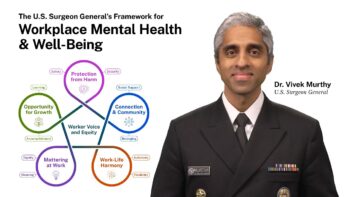Events of the last four years have changed the nature of work for many and the relationship that some workers have with their jobs. The Surgeon General’s Framework for Mental Health & Well-Being in the Workplace outlines the foundational role that workplaces should play in promoting the health and well-being of workers and communities. With more than 160 million … [Read more...] about Five essentials to support employee mental health and well-being
Covid-19
Employers need to realize some employees would rather quit than return to the office
By Lynne Curry “Doing time, that’s what going into the office to work feels to me.” “Like…jail?” “Like I’m selling my freedom for a paycheck. The bars close behind me every morning.” “Jim’s” employer didn’t want him to resign. “Could you interview him and find out if there’s anything we can do to keep him?” It took less than three minutes to learn—his employer’s return … [Read more...] about Employers need to realize some employees would rather quit than return to the office
CPT update for COVID-19 boosters adapted to omicron
The American Medical Association has announced an update to Current Procedural Terminology (CPT)®, that includes eight new codes for the bivalent COVID-19 vaccine booster doses from Moderna and Pfizer-BioNTech. The updated boosters are adapted for the BA.4 and BA.5 Omicron subvariants and the original coronavirus strain in a single dose. Four of the eight CPT codes (91312, … [Read more...] about CPT update for COVID-19 boosters adapted to omicron
Telehealth policy to change after the COVID-19 public health emergency
The COVID-19 public health emergency has been extended to Oct. 13. Of particular interest to medical practices is the continuation of telehealth flexibilities, which will expire at the end of the public health emergency. US Department of Health and Human Services Secretary Xavier Becerra officially renewed the declaration in mid-August. The emergency declaration has been in … [Read more...] about Telehealth policy to change after the COVID-19 public health emergency
What you should know about new COVID-19 guidance
CDC is streamlining its COVID-19 guidance to help people better understand their risk, how to protect themselves and others, what actions to take if exposed to COVID-19, and what actions to take if they are sick or test positive for the virus. COVID-19 continues to circulate globally, however, with so many tools available to us for reducing COVID-19 severity, there is … [Read more...] about What you should know about new COVID-19 guidance
5 ways to help your team members overcome burnout
The last couple of years have been rough on everyone in the healthcare field, including medical offices. Many suffered burnout early in the pandemic; others held it all together until now when they are quietly falling apart. Chances are someone on your team has had enough of the pressures from work, short staff and short resources, home responsibilities, family, finances, the … [Read more...] about 5 ways to help your team members overcome burnout
New physician population likely to be more diverse
The American Medical Association has committed itself to supporting a more diverse population of physicians to replace those physicians leaving the profession. The last two years of pandemic difficulties plus an aging physician workforce will likely result in an exodus from the field and a shortage of doctors. Gerald E. Harmon, M.D., president of the American Medical … [Read more...] about New physician population likely to be more diverse
Caregiver caught between employer’s expectations and family’s needs
By Lynne Curry As managers require employees to spend more time at the office, they will encounter special circumstances that require special solutions. Consider the following situation of an employee needing to work from home to provide family care. Employee question: Since our schools no longer require masks, my husband and I decided to homeschool our youngest child. My … [Read more...] about Caregiver caught between employer’s expectations and family’s needs
Medicare covering OTC COVID-19 tests
Starting this week and through the end of the COVID-19 public health emergency (PHE), Medicare covers and pays for over-the-counter (OTC) COVID-19 tests at no cost to people with Medicare Part B, including those with Medicare Advantage (MA) plans. In addition to helping prevent the spread of COVID-19, the goal is to find out if Medicare payment for OTC COVID-19 tests will … [Read more...] about Medicare covering OTC COVID-19 tests
Find the CDC’s new (relaxed) masking recommendations for your location
You can find the new COVID-19 masking recommendations your area on a map just released by the Centers for Disease Control (CDC). Recognizing that a substantial portion of the population has been vaccinated or has acquired some level of natural immunity, the agency has turned its focus to “protecting those at highest risk of severe outcomes” and minimizing the strain on … [Read more...] about Find the CDC’s new (relaxed) masking recommendations for your location








